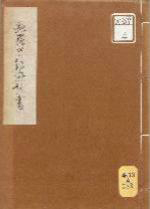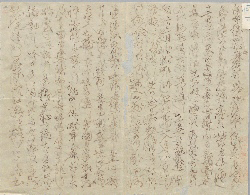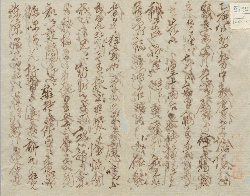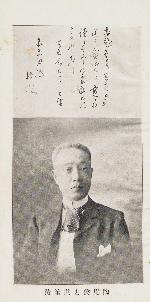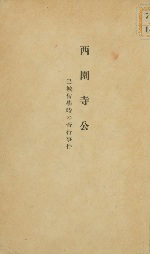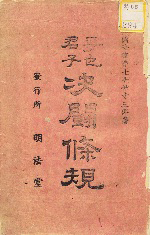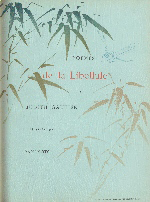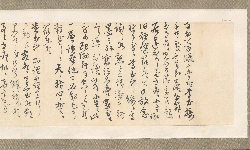![]()
Section 1: SAIONJI Kimmochi - Paris in his youth
The last of the original elders, SAIONJI Kimmochi (1849-1940) participated in the new government at age 18 after the Osei Fukko (Restoration of Imperial Rule) and served in the Boshin Civil War. Afterward, he quit the new government and was instructed to study abroad in France in December of 1870. This was actually as a result of a strong desire of SAIONJI himself, and his stay in France lasted approximately 10 years from 1871 to 1880. This was different from the study abroad of young members of the peerage in later years, and SAIONJI's life during his time abroad was simple. SAIONJI changed his name to the more commoner-like name Boichiro and studied at the private school of Émile Acollas (1826-1891) and the University of Paris. He also developed relationships with a variety of people, including not only other Japanese exchange students such as NAKAE Chomin (1847-1901) and KOMYOJI Saburo (1847-1893), but also the politician Georges Clemenceau (1841-1929) and author Edmond Huot de Goncourt (1822-1896). After returning to Japan from his study abroad, he still occasionally travelled to France as a diplomat and politician. The background to his preaching for international cooperation as a moderate liberal despite increasing militarism mounted was the profound education he developed in his studies in France.
SAIONJI Kinmochi, Yōroppa kiyū nukigaki, KOIZUMI Sakutarō, 1932 [W338-4] 
This is a report sent by SAIONJI during the first year of his study abroad to his father TOKUDAIJI Kin'ito (1821-1883) which was then collotype printed by KOIZUMI Sakutaro (1872-1937), who wrote SAIONJI's biography. In 1870 when SAIONJI departed, French mail ships were irregular due to the Franco-Prussian War, so he travelled aboard an American ship. At the beginning he notes his itinerary on an east-west dual hemisphere map, and he writes, "Actually making this journey has made me understand not to doubt that the earth is round". He travelled from San Francisco to the east coast by railroad, had a meeting with president Ulysses S. Grant (1822-1885) in Washington D.C. and travelled to Paris via New York and London. Regarding Paris he writes, "Paris is France's capital, and the magnificent architecture and cityscape are said to be the world's greatest." While SAIONJI excelled in Chinese studies, he regularly read FUKUZAWA Yukichi's (1834-1901) Seiyō Jijō and had a superior point of view among the Emperor's court at the time. Immediately before leaving for his study abroad, he learned French under Léon Dury (1822-1891) at Nagasaki language training school Kounkan.
SAIONJI Kinmochi shokan [Papers of SAIONJI Kinmochi (Former possessions of HASHIMOTO Saneyana), #4] 
This is a letter to HASHIMOTO Saneyana (1834-1885) of the same clan, written after arriving in France on June 13, 1871. Regarding the Paris Commune which ran from March 18 to May 28 of the same year his writing, "Since losing the Franco-Prussian War last year, France has had great internal upheaval, and shameless individuals incited the public in the name of republicanism, leading to an armed revolt", often attracts attention. He seeks the cause of the disorder in the "excessive showiness of customs," showing his concerns with Japan's excessive civilization. He states that "From this point on, only older individuals should be sent to travel abroad from Japan", and goes further saying, "In the event anyone advocating republicanism should appear, they should be decapitated as an example". However, SAIONJI's political views shifted to be more liberal during the course of his life studying abroad.
SAIONJI Kinmochi shokan [Papers of SAIONJI Kinmochi (Former possessions of HASHIMOTO Saneyana), #6] 
A letter addressed to HASHIMOTO on May 21, 1873. His study abroad expenses were paid for at government expense at first, but later switched to being privately paid so his financial situation was not good, and he often requested money. SAIONJI enrolled in the University of Paris Faculty of Law while also frequenting the private school of Émile Acollas, the Radical Left Party controversialist. In the letter he argues the bad influence of religion and criticizes church intervention in politics; this was likely the influence of his teacher. Also in the school was Georges Clemenceau, who would later become prime minister, and SAIONJI was close with Clemenceau, helping him smuggle in pamphlets published illicitly in Switzerland, etc. (for which he was scolded by resident minister SAMESHIMA Naonobu (1845-1880), who was worried about deterioration of Japan-French relations). They would meet again in later years at the Paris Peace Conference where SAIONJI served as Government Plenipotentiary. NAKAE Chomin also apparently studied under Acollas, and SAIONJI teased CHOMIN saying that "rather than studying seriously, he just argued constantly", however they were both involved together in the launch of the Tōyō Jiyū Shinbun [WB43-169] after returning to Japan. Their friendship continued even after SAIONJI joined the government, and SAIONJI supported Chomin's son Ushikichi (Chinese studies scholar, 1889-1942) after Chomin's death.
SAIONJI Kinmochi (Tōan), KUNIKIDA Doppo (Ed.), Tōan zuihitsu, Shinseisha, 1903 [97-99] 
This book includes essays by SAIONJI (pen name Toan) edited by KUNIKIDA Doppo (1871-1908). Doppo once lived at SAIONJI's residence when he was in financial difficulties. These essays were originally printed in the magazine Sekai no Nihon [雑54-11] launched by MUTSU Munemitsu (1844-1897) and edited by TAKEGOSHI Yosaburo (1865-1950). The magazine's name was intended to question the rise of ultranationalism and it is said to have been named by SAIONJI. SAIONJI did not like talking about himself, however he is said to have given in to a journalist's earnest request and wrote these essays modelled on Jules Simon (1814-1896), the Literati Chancellor under the third republic. These essays spell out his memories from his time studying abroad and as a diplomat in a free and unrestrained manner, and also include recollections of trying to obtain soy sauce in Paris (Nihon Ryōri), a record of his experiences in the Paris Commune (Hōjin nanigashi Pari ni kyōheki o kizuku), his meeting with KOMYOJI Saburo (Ikanaru kore fūryū). SAIONJI was a smart educated person and had a very progressive spirit, as evidenced by his quickly attending the imperial palace in Western clothing (Ōhara sanmi to seppuku o tosu) and other examples. HARADA Kumao (1888-1946) was SAIONJI's secretary in his later years and his Tōan kō seiwa [310.4-Sa22ウ] includes a number of similar episodes.
KOIZUMI Sakutarō, Saionji kō: Hajō ryūgakuji no kikō jiken, KOIZUMI Sakutarō, 1937 [715-149] 
This is an investigation by KOIZUMI Sakutaro into the supposed incident where, according to popular history, SAIONJI and KOMYOJI ran amok at the Paris café Seikiro (lit. Star Flag Pavilion). According to KOIZUMI, Seikiro referred to Cafe American (a famous Paris café also mentioned in Guy de Maupassant's (1850-1893) Bel-Ami) and according to Toan Zuihitsu was also the café where SAIONJI and KOMYOJI first met. The truth of the matter seems to be that they defended a prostitute who damaged a mirror in the café and KOMYOJI paid for the damages for her and then smashed the mirror in front of the café staff.
KOMYOJI was sent by the Choshu Domain to study law in France. It is said his original last name was Mitsuda, however he used the name of a temple in his hometown in imitation of SAIONJI. He did not comply with the order for study abroad students to return to Japan in 1874 and instead continued his study abroad as with SAIONJI and earned his Bachelor of law. When SAIONJI visited Paris again in 1897, the poem he wrote (Like a ghostly dream, I remember this café from 20 years ago, countless weeping willows live, and the reason I am sad is not only that KOMYOJI is no longer here.) in memory of KOMYOJI, who died young, became one of the Meiji Era's most famous Chinese-style poems.
KOMYŌJI Saburō, Kettō jōki: soya kunshi, Meihōdō, 1889 [特55-294] 
After returning to Japan KOMYOJI worked translating legal documents. From around the 1880s onward, Japanese began to imitate the duels which were a custom in Western countries and there were uproars regarding duels throughout the country. There were debates on whether duels should be forbidden under the criminal code, and the majority of intellectuals argued that it should be prohibited, however KOMYOJI, who was known as something of a dandy, gave a speech stating, "Duels are the flower of civilization" at a Symposium of five major law schools and had a major impact. This text argues for the approval of duels while also providing proposals for the rules of such duels, resembling the Seikiro incident of his youth. KOMYOJI also served as a member of the House of Representatives after working for the Tōyō Jiyū Shinbun newspaper. In his speech on the arrest of Diet members at the first session of the Imperial Diet (Stenographic Record No. 1 of the 1st Ordinary Session of the Diet, in which SUEMATSU Saburo refers to KOMYOJI) he was eloquent, earning him the nickname "the Asian Clemenceau", however he was reduced to poverty in his later years. He had a child with the beautiful Yoshicho geisha, Yonehachi (later the new school actress CHITOSE Beiha, 1855-1913), whom SAIONJI fostered after KOMYOJI's death, and who later became the actor AZUMAYA Saburo (1892-1935).
Judith Gautier (traduits du Japonais d'après la version litterale de M. Saionzi ; illustrés par Yamamoto), Poëmes de la libellule. Gillot, [1885] [KH9-B13] 
This is an abridged translation of the kana foreword and 88 poems from the Kokin Wakashū by SAIONJI together with female author Judith Gautier (1845-1917), which was published in Paris. The Japanese name of the work is Seireishū. Judith, who was the daughter of romanticist author Théophile Gautier (1811-1872), was known for works under the theme of Asia. Judith arranged SAIONJI's verbatim translation (found on the last page) in 5, 7, 5, 7, 7 syllables. SAIONJI did not care for 31 syllable Waka poetry, however having been born to high ranking imperial court nobility, he was sufficiently familiar. Illustrator YAMAMOTO Hosui (1850-1906) was a Western-style painter who studied abroad in France and had a relationship with SAIONJI through art dealer HAYASHI Tadamasa (1853-1906). The beautiful multicolor printed bookmaking is representative of Japonisme and the date of publication and author indication "written by Judith" are on the wings of the dragonfly on the cover. The dedication by Judith to KOMYOJI (A Mitsouda Komiosi), using the familiar second person pronoun "tu", is stated as evidence in some opinions that the two were lovers. The attractive Judith was a queen of the salon.
Edmond Louis Antoine Huot de Goncourt, NOGUCHI Yonejirō (Tr.), Utamaro, Daiichishobō, 1939 [567-28] 
Edmond Huot de Goncourt and his younger brother Jules (1830-1870) were authors known as the Goncourt brothers. Their diaries are considered a fundamental material for understanding French society and the literary world in latter half of the 19th century. They left behind the Gouncourt Prize, which is France's highest literary honor, and Judith Gautier served as a member of the prize committee for the award. According to the diaries, Gouncourt obtained a Japanese sword which once belonged to SAIONJI through the art dealer Philippe Burty (1830-1890) and apparently this served as the beginning of relations between the two. He was known as a pioneer in Japonisme, and collected ukiyo-e paintings as a customer of HAYASHI Tadamasa and published the first books on ukiyo-e, Outamaro [KC172-A65] and Hokousaï [VF5-Y3253] with the assistance of HAYASHI. The translator, NOGUCHI Yonejiro (Yone Noguchi, 1875-1947) was a poet and ukiyo-e researcher who was known as being the father of sculptor Isamu Noguchi (1904-1988). In addition, the publisher Daiichi Shobo was founded by HASEGAWA Minokichi (1893-1973), who trained at Gembunsha, the publishing arm of cosmetics company Ito Kochoen, and he established an age of luxurious bookbinding from the Taisho Era to before World War II.
SAIONJI Kinmochi shokan [Papers of INOUE Kaoru, #482-3]
This is a private letter sent from SAIONJI, as the resident minister to Germany, to INOUE Kaoru (1835-1915) Minister of Agriculture and Commerce on February 21, 1889. The content is mainly congratulating INOUE's foster son, Katsunosuke (referred to as "Katsu-kun" throughout the letter, 1861-1929), who was working at the legation to Germany at the time but was retiring and heading to Britain to study abroad, and there is also mention of the French language ability of Katsunosuke's wife, Sueko (referred to in the letter as "Osue-sama", 1864-1934). Sueko was known as a talented woman who could communicate in English, French and German, and was famous for her beauty which made her the flower of the social circles. SAIONJI regretted that when Katsunosuke retired, his wife would be sent back to Japan, and stated, "It is necessary to be able to speak French in order to interact with the upper classes in Europe", and recommended that INOUE, "Have her study advanced French in Paris, France". In the end, Minister of Foreign Affairs OKUMA Shigenobu (1838-1922) did not approve Katsunosuke's retirement and he was unable to study abroad, but Sueko did go to study languages in Paris. SAIONJI also frequently took vacation time for leisure in Paris during his time as resident minister in Germany.

